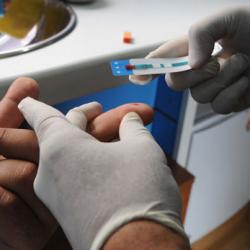It is dangerous to believe that the end of AIDS is in sight. About 30 million people around the world live with HIV, and another 30 million are likely to become infected in the next decade if current trends persist. Funding from developed governments is dropping—a trend that must be reversed. But we also need to acknowledge that billions of dollars have been spent on well-meaning attempts to save lives, and there has been an alarming lack of high-quality evaluation of how these investments have performed.
This is true not only of abstinence campaigns, for which there is no evidence of effectiveness, but also for many other mainstays of the AIDS response. On a systemic level, we do not know what works, where, and why—or how to replicate our successes.
In the project RethinkHIV, the Copenhagen Consensus Center and the Rush Foundation asked 30 of the world’s top HIV economists, supported by epidemiologists, demographers, and medical professionals to analyze the most promising responses to the epidemic in the world’s worst-hit region, sub-Saharan Africa. They were asked to examine what could be achieved with extra investments in six key areas: prevention of sexual transmission, reduction of nonsexual transmission, treatment of those who have the disease, initiatives to use social policy and health-system strengthening to fight HIV/AIDS, and vaccine research.
The resulting research papers offer the first-ever comprehensive attempt at cost-benefit analysis of AIDS priorities. Economics can offer a fresh perspective by showing us the overall value to society of competing spending options. Among worthwhile investments, some are very costly and achieve little good; others are remarkably cheap and incredibly effective. Whether on AIDS or other problems, additional funds should be spent first where we can achieve the highest return for our money.
To spark a dialogue about HIV/AIDS priorities based on the RethinkHIV research, the Copenhagen Consensus Center and the Rush Foundation asked five world-class economists—including three Nobel laureates—to form their own conclusions about how best to spend additional funding. The panel zeroed in on five investments that they believe should be at the top of policymakers’ lists.
Most important, they identified an urgent need for increased investment in developing an HIV vaccine. This is clearly a longer-term response to the epidemic: Research by Dean Jamison and Robert Hecht (PDF) for RethinkHIV suggests that we are about 20 years away from large-scale vaccination, and that increasing current funding by around 10 percent, or $100 million a year, would meaningfully shorten that projection. This would save millions of lives and potentially end the epidemic in the long run, while dramatically improving scientific understanding of the disease in the near term. For every dollar spent, it is likely that the benefits would run into the tens of dollars.
As a shorter-term response to the epidemic, the Nobel laureates were convinced by research by the economist Lori Bollinger (PDF) that we could practically wipe out mother-to-child transmission of HIV by 2015 with additional expenditures of just $140 million a year. About 350,000 infants became HIV positive in 2008, through pregnancy, labor, delivery, or breast-feeding, accounting for approximately 20 percent of all new infections. Since we have such cost-effective programs to halt this tragedy, the Nobel laureates concluded, this is a compelling investment.
So, too, is spending more to make blood transfusions safer. Bollinger calculates that annual investment of $2 million over five years would achieve 100 percent safe blood transfusions by 2015 and avert more than 131,000 HIV infections, while alleviating fears of infection for the almost half-billion people who would otherwise receive blood that was not comprehensively screened.
The Nobel laureates also found that male circumcision is an excellent use of funds. They focused particularly on the longer-term benefits of infant-male circumcision, arguing that there is massive untapped potential to introduce this very cheap practice across Africa. We know that adult-male circumcision reduces the odds of transmission from a woman to a man by up to 60 percent. Research by Jere Behrman and Hans-Peter Kohler (PDF) of the University of Pennsylvania makes clear that the real focus needs to be on working out the best ways to broaden adult circumcision efforts across the region, and to convince men that getting circumcised is a good idea. We also need to introduce counseling to ensure that men do not treat circumcision as a vaccine, and engage in riskier behavior as a result.
Finally, the panel of Nobel laureates concluded based on research by Mead Over and Geoffrey Garnett (PDF) that additional resources for treatment should go first to patients who are the sickest and most infectious. Because treatment is very expensive, coverage rates remain woefully inadequate. But treatment is not only an ethical imperative; it also is important in preventing and reducing sexual transmission.
The expert panel did not just identify the top-priority uses for additional funds. It also highlighted promising areas where more research is needed. As Anna Vassall, Michelle Remme, and Charlotte Watts of the London School of Hygiene and Tropical Medicine point out (PDF), gender inequalities and domestic violence are both associated with a significant increase in risk of HIV infection. So, if gender training programs were to piggyback on current income-boosting microfinance and agricultural-support programs, we could undermine norms about gender roles that entrench women’s dependence on men or condone domestic violence. It’s a proposal that deserves further investigation, as is the proposition from William McGreevey of Georgetown University (PDF) to increase efforts to focus treatment of HIV-positive patients to reduce opportunistic infections of cryptococcal meningitis.
We need to arrest the recent drop in AIDS funding and secure additional resources in order to make further headway against the disease. By highlighting sound investments—including some that are not currently at the top of policymakers’ to-do lists—RethinkHIV makes the case in economic terms for doing just that.
This article comes from Project Syndicate.
